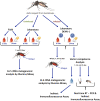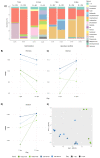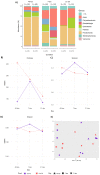Ingestion of amoxicillin-clavulanic acid at therapeutic concentration during blood meal impacts Aedes aegypti microbiota and dengue virus transmission
- PMID: 38871831
- PMCID: PMC11176339
- DOI: 10.1038/s41598-024-64221-2
Ingestion of amoxicillin-clavulanic acid at therapeutic concentration during blood meal impacts Aedes aegypti microbiota and dengue virus transmission
Abstract
Dengue virus (DENV), mainly transmitted by Aedes aegypti mosquitoes, is the most prevalent arbovirus worldwide, representing a public health problem in tropical and subtropical countries. In these areas, antibiotic consumption rises which may impact both mosquito microbiota and dengue transmission. Here, we assessed how the ingestion by Ae. aegypti of therapeutic concentrations of amoxicillin-clavulanic Acid association (Amox/Clav), a broad-spectrum antibiotic used to treat febrile symptoms worldwide, impacted its microbiota. We also evaluated whether simultaneous ingestion of antibiotic and DENV impacted Ae. aegypti ability to transmit this virus. We found that Amox/Clav ingestion impacted microbiota composition in Ae. aegypti and we confirmed such impact in field-collected mosquitoes. Furthermore, we observed that Amox/Clav ingestion enhanced DENV dissemination and transmission by this mosquito at 21 days post-DENV exposure. These findings increase our understanding of factors linked to human hosts that may influence dengue transmission dynamics in regions with mass-drug administration programs.
© 2024. The Author(s).
Conflict of interest statement
The authors declare no competing interests.
Figures




Similar articles
-
Dengue-1 virus and vector competence of Aedes aegypti (Diptera: Culicidae) populations from New Caledonia.Parasit Vectors. 2017 Aug 9;10(1):381. doi: 10.1186/s13071-017-2319-x. Parasit Vectors. 2017. PMID: 28793920 Free PMC article.
-
Vertical transmission of dengue virus in Aedes aegypti and its role in the epidemiological persistence of dengue in Central and Southern Mexico.Trop Med Int Health. 2019 Nov;24(11):1311-1319. doi: 10.1111/tmi.13306. Epub 2019 Oct 8. Trop Med Int Health. 2019. PMID: 31483936
-
Potential of Aedes aegypti populations in Madeira Island to transmit dengue and chikungunya viruses.Parasit Vectors. 2018 Sep 12;11(1):509. doi: 10.1186/s13071-018-3081-4. Parasit Vectors. 2018. PMID: 30208974 Free PMC article.
-
The effect of temperature on dengue virus transmission by Aedes mosquitoes.Front Cell Infect Microbiol. 2023 Sep 21;13:1242173. doi: 10.3389/fcimb.2023.1242173. eCollection 2023. Front Cell Infect Microbiol. 2023. PMID: 37808907 Free PMC article. Review.
-
The Global Expansion of Dengue: How Aedes aegypti Mosquitoes Enabled the First Pandemic Arbovirus.Annu Rev Entomol. 2020 Jan 7;65:191-208. doi: 10.1146/annurev-ento-011019-024918. Epub 2019 Oct 8. Annu Rev Entomol. 2020. PMID: 31594415 Review.
References
-
- WHO. Dengue and severe dengue. https://www.who.int/news-room/fact-sheets/detail/dengue-and-severe-dengue (2024).
MeSH terms
Substances
LinkOut - more resources
Full Text Sources
Medical

